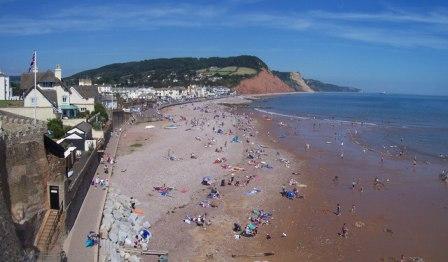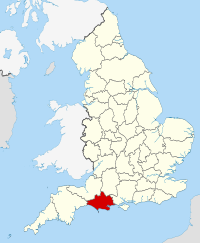
Sidmouth Beach, Jurassic Coast - © Lewis Clarke
The Dorset & East Devon Coast is located in the South West of England and became a World Heritage Site (WHS) in 2001. The WHS is approx 95 miles in length along the coastal route that stretches from Orcombe Point close to Exmouth in East Devon to Old Harry Rocks close to Swanage in East Dorset. The coast offers a wealth of wonderful natural coastal scenery, interesting towns and villages to visit and visitor attractions along the way for visitors to enjoy. The coast and its surroundings offer visitors the chance to see an area rich in culture and history, the beaches and above average sunshine for the UK make the area an interesting one for visitors.
Overview
The Dorset & East Devon Coast is also referred to as the Jurassic Coast and is one of the few wholly natural designated World Heritage sites in the UK. The area along the route stretches for 95 miles across the counties of Devon and Dorset on the south west coast of England. The World Heritage Site status has brought with it a greater awareness of the area and the preservation and conservation work that is required to maintain the area for future generations. The area is world renowned for the cliff exposures on the East Devon and Dorset coasts that show the near continuous sequence of rock formations that cover approx 185 million years of the earth's history. The cliff exposures provide visitors with a walk through the ages that include the Jurassic and Triassic periods. The area is also significant for the fossil sites and the associated coastal geomorphologic features, these have helped in the study of earth sciences for many centuries.
Along the coastal path there are a number of Gateway Towns and Villages that provide visitors with local attractions and events to enjoy along with visitor accommodation. The actual Gateway towns and villages offer services that are in accordance with plans to preserve and protect the Jurassic Coast. There are number of interesting Gateway towns and villages visitors can visit on route, some interesting ones include:
The famous resort of Exmouth is located on the western boundary of the WHS and offers visitors with golden sandy beaches to enjoy, there are water sports such as sailing, water skiing, paragliding and more. Activities associated with British resorts such as crazy golf and a range of sea front shops are also evident here.
Budleigh Salterton along the coast from Exmouth is a small and relaxed seaside town, that perfectly illustrates the picture perfect postcards associated with British seaside resorts. There are a number of cottages in this picturesque town, there is a pebble beach here and a small local museum to visit that details the local areas history and geology.
Sidmouth on the coast is located approx 15 miles from Exeter, the small town retains a charm and character more associated from a by gone era making for a pleasant place for visitors to see on their travels. There are nice beaches to enjoy along with gardens and the area offers a number of picturesque walks. Visitors can also go on boat trips to explore the in local area further.
Lyme Regis is a coastal town located approx 25 miles from Exeter along the Jurassic Coast, the town is also set with the boundary of an Area of Outstanding Natural Beauty (AONB), it is also known as the 'Pearl of Dorset.' The town is famous for 'The Cobb' harbour wall, the area gained importance as the port grew in importance of the years. The town mill dating back to the 14th century has undergone restoration and is still producing flour. The local parish church is St Michael’s and the Philpot Museum that exhibits local artefacts and memorabilia along with explaining more about local history and culture are also worth seeing for visitors.
Seaton is a small beach town located in the Axe Valley, the town gained prominence in the 19th century and has a number of Victorian buildings from that time. The town is well known fro its holiday camps over the years and they are still present today catering for visitors to the town. There is a tramway taking visitors to near by towns and a lovely stretch of coastline offering plenty for beach lovers.
Charmouth further along the Jurassic coast is well known for fossils, the large beach and the presence in the area of the Heritage Coast Centre on the seafront mean it is a great place for those interested in learning more about fossils and the local history and geology. Many walkers walk on the beaches here searching for fossils in inspiring surroundings.
West Bay is a harbour village located on the coast, the village is located with some wonderful natural scenery and stunning cliffs on either side. For visitors there is a visitor centre in the area along with a museum to explore and local boat trips to enjoy and of course the scenic beach.
Portland is an island that can only be explored further on foot. There are a number of cross island and coastal pathways that allow visitors to do this. There is a lighthouse, visitor centre and museum for visitors to see. The island offers some stunning panoramic views for visitors.
The town of Weymouth is a major Gateway town on the coast, there are a number of historic buildings in the town a testament to its history. There is a town centre offers visitors the chance to relax inside a traditional British pub and enjoy some refreshments, there are also restaurants and bars offering a range of food and drinks. Weymouth offers more sunshine than most places in the UK including in the winter time, making it an enjoyable place for visitors to explore. There are a number of attractions for visitors here including a museum detailing local history and interest, a castle/fort, historic houses, water gardens and the famous three mile beach.
Swanage is town located on the eastern boundary of the World Heritage Site and has long been a favourite for families boasting a wonderful beach and a range of family attractions and entertainment. Located approx 6 miles from Poole in Dorset, attractions include the restored steam railways and the Victorian Pier associated with traditional English seaside towns. There are a range of water sports on offer at the beach and visitors to the town are treated to some great views.
How To Get There
The World Heritage Site on the Dorset and East Devon Coast is accessible by car and public transport:
By Car:
If you are travelling from London take the M5 up to junction 30 and then take the A3052 which then takes you to the Gateway towns on the route from Sidmouth to Lyme Regis. Those wish to go to Exmouth should take the A376 from junction 20 of the M5. The B3178 links Exmouth to Budleigh Salterton.
From Bournemouth the A35 and then the A354 takes you to Weymouth on the route. Also taking the A35 from Bournemouth and then the A351 takes you to Swanage on the Eastern boundary of the WHS.
By Train:
South West Trains offers services from London Waterloo station to Weymouth in Dorset, the journey time is approx 2 hours and 50 minutes.
There are also train services from London Waterloo to Exeter Station, the journey time is approx 3 hours and 45 minutes. From Exeter Station travellers should take the Avocet Train line to Exmouth, the journey time is approx 25 minutes.
By Bus:
The Jurassic Coast Bus Service is a popular service for walkers who wish to explore the coastal path themselves and be able to use the bus to get to and from locations along it.
The service connects areas such as Exeter, Sidford, Beer, Seaton, Lyme Regis, Charmouth, Bridport, and Weymouth and up to Poole.
For more information please see: Public Transport Details for details on exploring the coast by public transport.
Contact Details
Address:
Weymouth Tourist Information Centre
The King's Statue The Esplanade
Weymouth
DT4 7AN
United Kingdom
Telephone: +44 (0)1305 785747
Website: Dorset & East Devon World Heritage Site
Facilities and Information
Further Information:
There are a number of towns and villages that visitors can see along the coastal path, the larger towns include Weymouth and Exmouth and with the tourist information centres and facilities make for a useful place to start exploring the coast, Exmouth from the Western side and Weymouth from the eastern side.
Given the stretch of coast measures close to 100 miles it may be useful for visitors to go to the local Tourist Information Centres or contact them over the telephone to get a better idea of the range of attractions, events and places of interest that are located along the route.
It is of course also possible for visitors to go themselves along the coastal route and discover the towns and villages themselves.
Map
View Larger Map
For Local Search and Directions see: Dorset & East Devon Coast Map
Tips & Other Considerations
There may be some variations on the opening hours of the various visitor attractions at the route of the Coastal path, depending on the time of year and other factors. Visitors are advised to double check each attraction they wish to see before going & avoid disappointment.
Visitors to the entire coastline area should be aware of and follow safety precautions. The coastline and cliffs on the coastal path can present dangers of high tides, moving rocks, landslips and mudflows. Visitors should not climb on the cliffs, ensure they stay away from cliff edges and strictly observe all danger and warning signs in the area.
When travelling always remain alert and aware of your surroundings and environment and follow safety tips. Ensure your belongings in particular your wallet/purse and valuables are hidden away from public view (especially at tourist attractions & places with crowds). If you have a bag try to use a shoulder bag with a good quality, strong strap, that is put across your shoulder not on your shoulder making it more difficult for anyone to take your bag.
If you are travelling by car to the Devon and Dorset Coast site, ensure you are well prepared with maps and Sat Nav to aid your journey, particularly if you are not familiar with the local area and roads. There are a number of narrow and hilly roads including those by the coast, drivers should ensure they drive safely and exercise caution at all times. For door to door directions use the Route & Journey Planning tool.
If you are looking for local car parking along the various coastal towns and villages, ensure you fully understand the rules, regulations & charges for car parks and street parking before you park your car. The parking rules and regulations can be complex if you are not sure it is wise not to park there.
If you are travelling by public transport, check for service updates prior to beginning your journey for any delays, disruption or cancellations to services that may impact on your journey. Ensure you have the service timetables for the trains, buses and coaches. Remember when the last services are and ensure you make it to the train/bus/coach stops well in time to avoid missing the service.
Disclaimer: The information given in on this website is given in good faith and to the best of our knowledge. If there are any discrepancies in no way do we intend to mislead. Important travel details and arrangements should be confirmed and verified with the relevant authorities.


